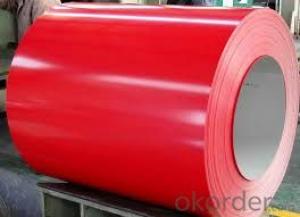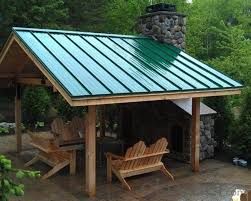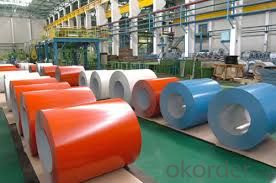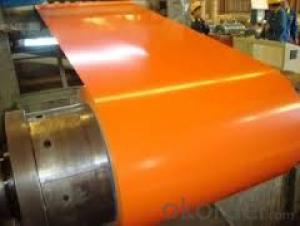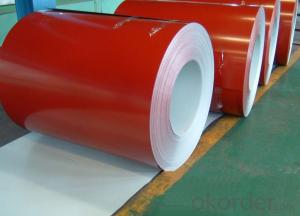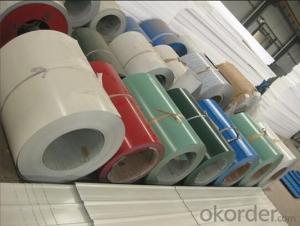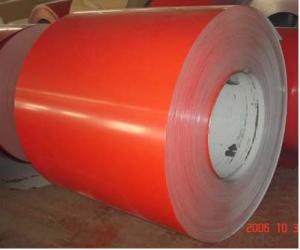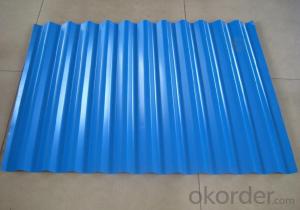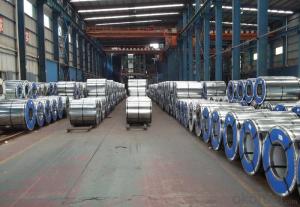Cold Rolled Galvanized Steel with Color Prepainted
- Loading Port:
- Shanghai
- Payment Terms:
- TT OR LC
- Min Order Qty:
- 20 m.t.
- Supply Capability:
- 9000 m.t./month
OKorder Service Pledge
OKorder Financial Service
You Might Also Like
Product Description
1. Prepainted cold rolled steel simple introduction:
Prepainted cold rolled steel is also named prepainted galvanized steel coil, which is produced by a new type of modern technology, which employs radiation hot-dipped galvanizing process mainly
Adopts the finishing hot galvanized steel as the raw material, then printing and baking
Some special colorful paint. Through this method, Prepainted cold rolled steel has the organic coating to
Protect itself from rusting, which would extend its service time as longer as 1.5 times
Than the usual galvanized steel coil.
2. Prepainted cold rolled steel special scope and products
1)Length: 762/900/914/1040/1215
2)Printed, Filmed, Pressed, Matte steel coil/sheet
2)G550 full hard
3. Prepainted cold rolled steel features:
-Corrosion resistance.
-Formability.
-Decoration.
- Excellent Workability.
4. Prepainted cold rolled steel applications fields:
Roofing and walling, curved profiles, corrugated sheets, foamed sandwich panels for roofing and walling, roof tills, rainwater gutter, metal doors, garage doors, wall panels for partitions, ceiling panels, suspended frames, interior metal doors or windows, profiles for exterior cabinets of white appliances, office furniture, home appliances, etc. Ppgi steel coil prepainted cold rolled steel coils
5. Prepainted cold rolled steel quality control:
Strict procurement process---skillful technical workers---final products inspection
(resistance to corrosion, salt spray test, exposure test, machinability, thermal resistance)
---standard packing
6. Prepainted cold rolled steel process:
Pay off reel-double cut shear-jonter-pre cleaning section-dryer-entry accumulation-cleaning section-chemical coater-chemical oven-primer coater-prime oven-prime coater cooling unit-dryer-finish coater-finish oven-finish coater cooling unit-dryer-tension leveler-exit accumulator-exit shear-tension reel
commodity | Prepainted cold rolled steel |
width | 600-1250mm |
thickness | 0.14-5mm |
standard | JIS G 3302-1998, ASTMA653M, GB/T 2518, Q/CHG3-2005, EN 10142, DX51D,ENG10142,SGCD(DX52D+Z) |
coil weight | 3-5 MT (Can be customized) |
technique | Hot dipped galvanized, alu-zinc coating, pre-painted, color coating, etc |
zinc coating | 60-275g/m2 |
tolerance | Thickness: +/-0.02mm Width: +/-2mm |
surface processing | Regular spangle, minimized spangle, zero spangle, bright spangle, etc |
application | Steel structure, building exterior application, building material, roofing household, application, tube making, etc^ |
product feature | Good performance, high precise, high straightness, high evenness and surface finishing, uniform thickness, easy for coating process, high tensile strength, high pressing property and low yield point |
package | Wrapped with waterproof paper inside, galvanized steel covered, tied by steel strip, supported by pallet, then loaded in container or according to customer' requirements |
delivery | Normally 10-20 days after get deposits or according to the quantity |
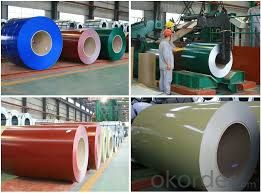
FAQ
1. Is the sample available?
Yes, samples can be sent for test if you need.
- Q: Why is iron used to create steel? Why not other elements?
- iron came before steel. iron is what was discovered that, under certain circumstances, became a stronger metal: steel. that is why. its like asking why copper is in bronze. because what we call bronze, is an alloy of copper and tin. if you give a more detailed question, i may be able to give a more detailed answer.
- Q: What are the different methods of engraving steel coils?
- There are several different methods of engraving steel coils, each with its own advantages and applications. Some of the most common methods include: 1. Chemical Etching: This is a process that involves applying a chemical solution to the surface of the steel coil, which selectively removes the metal to create the desired design. Chemical etching is highly precise and can produce intricate patterns and fine details. It is commonly used for decorative purposes, such as creating logos or patterns on steel coils. 2. Laser Engraving: Laser engraving uses a high-powered laser beam to remove the top layer of the steel coil, creating a permanent mark. This method offers high precision and allows for the engraving of complex designs, logos, or text. Laser engraving is frequently used for branding purposes or to add identification marks to steel coils. 3. Mechanical Engraving: Mechanical engraving involves the use of a cutting tool or a diamond-tipped stylus to physically remove the metal from the steel coil's surface. This method is known for its durability and versatility, as it can create deep and long-lasting engravings. Mechanical engraving is often used for industrial applications, such as adding serial numbers, part codes, or other identification marks to steel coils. 4. Electrochemical Etching: Electrochemical etching, also known as electrolytic etching, utilizes an electric current to selectively dissolve the metal surface of the steel coil. This technique is commonly used for marking and branding purposes, as it can produce high-quality, permanent engravings. Electrochemical etching is often employed in industries where precision and durability are essential, such as aerospace or automotive manufacturing. 5. Inkjet Printing: While not strictly engraving, inkjet printing is a method that can be used to add patterns or designs onto steel coils. This process involves using specialized inks and a digital printing system to apply the desired design directly onto the surface of the coil. Inkjet printing is versatile, cost-effective, and allows for high-resolution prints, making it suitable for various applications, including decorative or branding purposes. In conclusion, the different methods of engraving steel coils offer a range of options for creating permanent markings, logos, or patterns. The choice of method depends on factors such as the desired level of precision, durability requirements, and the specific application for the steel coil.
- Q: How are steel coils used in the production of steel drums?
- Steel coils are used in the production of steel drums by being cut into sheets and then rolled into cylindrical shapes, which form the body of the drum. The coils provide the necessary strength and durability required for the drums to hold and transport various materials safely.
- Q: How are steel coils used in the production of aerospace structures?
- Steel coils are used in the production of aerospace structures in various ways. One of the main applications is in the manufacturing of aircraft frames and components. Steel coils are often used as the raw material to fabricate the structural members of an aircraft, such as fuselage sections, wing spars, and landing gear. The coils are typically processed through a series of operations, including cutting, bending, and welding, to shape them into the required structural components. Steel coils are preferred in aerospace applications due to their high strength and durability. They can withstand the extreme forces and stresses experienced during flight and landing. The use of steel coils ensures that the aerospace structures have the necessary structural integrity to endure the harsh operating conditions. Additionally, steel coils are also used in the production of aerospace fasteners and connectors. These fasteners play a crucial role in holding various components and structures together. Steel coil materials are often used to manufacture bolts, screws, and rivets, which are essential for assembling different parts of an aircraft. The strength and reliability of steel coils make them suitable for fastening applications, ensuring that the aerospace structures remain securely connected. Furthermore, steel coils are utilized in the production of aerospace equipment and machinery. Many aerospace manufacturing processes rely on heavy machinery and specialized equipment. Steel coils are commonly used in the construction of these machines due to their ability to provide robust and sturdy frameworks. They are often employed in the fabrication of tooling, jigs, fixtures, and molds, which are essential for producing aerospace structures with precision and accuracy. In summary, steel coils play a vital role in the production of aerospace structures. They are used as raw materials for manufacturing aircraft frames and components, fasteners and connectors, as well as aerospace equipment and machinery. The strength, durability, and reliability of steel coils make them indispensable in the aerospace industry, ensuring the safety and integrity of aerospace structures.
- Q: I'm going to buy a guitar for beginners and i wondered what strings are better steel or nylon?
- It okorder /
- Q: How are steel coils tested for strength and durability?
- Steel coils are typically tested for strength and durability through a series of rigorous procedures such as tension and compression tests, hardness tests, and impact tests. These tests help determine the coil's ability to withstand various loads and impacts, ensuring that it meets the required strength and durability standards. Additionally, other tests like fatigue tests and corrosion resistance tests may also be conducted to further assess the coil's performance and longevity.
- Q: What are the different coating options for steel coils?
- There are several coating options available for steel coils, each serving different purposes and providing unique benefits. Some of the commonly used coating options for steel coils include: 1. Galvanized Coating: This coating involves immersing the steel coils in a bath of molten zinc, creating a layer of zinc on the surface. Galvanized coating provides excellent corrosion resistance and protects the steel from rusting. It is commonly used in applications where the steel coils are exposed to harsh environments or moisture. 2. Galvannealed Coating: This coating is a combination of galvanizing and annealing processes. The steel coils are first galvanized and then annealed to create a layer of zinc-iron alloy on the surface. Galvannealed coating offers enhanced paintability and weldability while providing good corrosion resistance. 3. Aluminum-Zinc Alloy Coating: Also known as Galvalume, this coating consists of an aluminum-zinc alloy applied to the steel coils. It provides excellent corrosion resistance and heat reflectivity, making it suitable for various applications, including roofing, siding, and automotive parts. 4. Organic Coatings: These coatings are typically applied as a top layer over a base coat of galvanized or galvannealed coating. Organic coatings can be in the form of paints, lacquers, or powder coatings. They provide additional protection against corrosion, UV rays, and abrasion, while also enhancing the aesthetics of the steel coils. 5. Chromate Conversion Coating: This coating is primarily used as a pre-treatment before applying organic coatings. It helps improve adhesion between the steel surface and the organic coating, ensuring better corrosion resistance. The choice of coating depends on various factors such as the intended application, environmental conditions, desired appearance, and budget. Manufacturers and end-users should carefully consider these factors to select the most suitable coating option for their specific requirements.
- Q: What is the maximum stacking height for steel coils?
- The maximum stacking height for steel coils depends on several factors, including the weight and dimensions of the coils, as well as the storage facility's structural capacity. Generally, it is recommended to consult the manufacturer's guidelines or industry standards to determine the specific maximum stacking height for steel coils.
- Q: How are steel coils used in the manufacturing industry?
- Steel coils are used in the manufacturing industry for a variety of purposes such as making automotive parts, appliances, construction materials, and machinery. The coils are typically unwound and processed into sheets or strips, which can then be shaped, cut, or formed into the desired finished product. The versatility, strength, and durability of steel make it a valuable material in the manufacturing process, and the use of coils helps maximize efficiency and productivity.
- Q: I juuuust got a new stainless steel sink only 5 months ago, and it already has a couple rust spots on it.What caused this?!
- Use a soft cloth or nylon sponge and a little bit of detergent on the spot. Do not use bleach, chlorine or otherwise. If this does not work, try a little baking soda. Always rince out the sink after you use it, soap film can leave a rainbow looking mark in the stainless steel. I take everything out of the sink after I wash dishes. I use a small amount of veg oil on a paper towel to shine up the sink.
Send your message to us
Cold Rolled Galvanized Steel with Color Prepainted
- Loading Port:
- Shanghai
- Payment Terms:
- TT OR LC
- Min Order Qty:
- 20 m.t.
- Supply Capability:
- 9000 m.t./month
OKorder Service Pledge
OKorder Financial Service
Similar products
Hot products
Hot Searches
Related keywords
